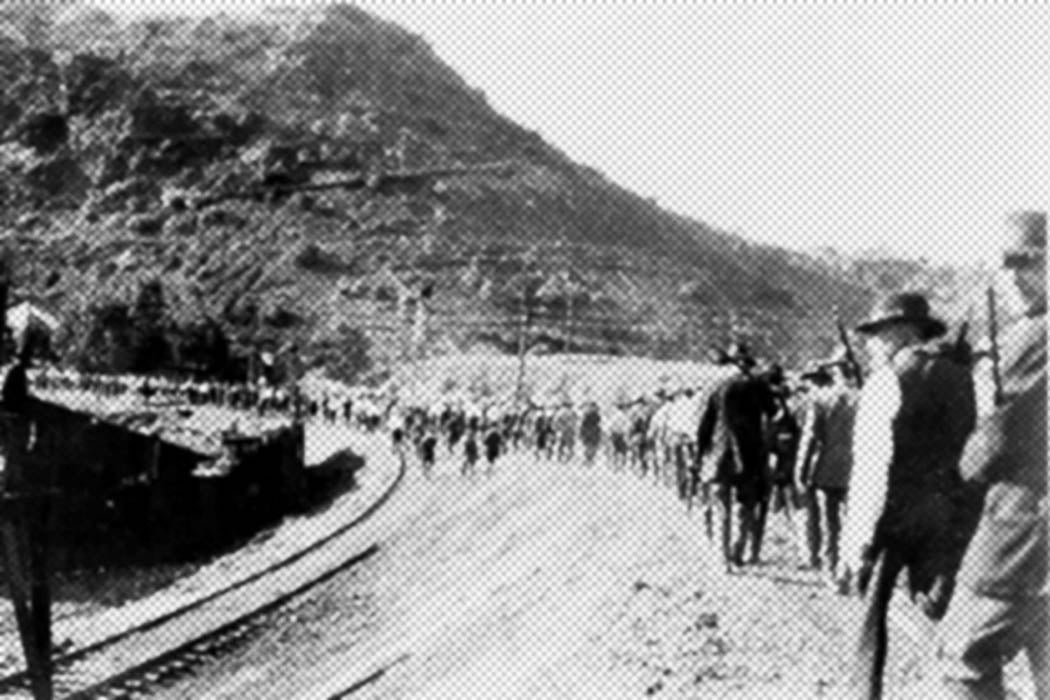On July 12th, 1917 in Bisbee, Arizona, over a thousand striking copper miners–along with regular townsfolk like restaurant owners, carpenters, and exactly one lawyer–were rounded up at gun-point, herded into boxcars, and taken two hundreds miles into the desert. A new movie, Bisbee ’17, opening next month, tells the story anew.
The miners were left out in the desert to fend for themselves, until a nearby army camp rescued them. Few of them ever returned to Bisbee. Most of these miners were Mexican and Eastern European immigrants, others were Mexican-Americans. Although not strictly a deportation, since they weren’t sent across any national border, the action became known as the Bisbee Deportation.
Historian Katherine Benton-Cohen writes that this event has been looked at through many lenses, but she argues that it wasn’t “about labor relations or race or gender: it was about all of them.”
“White Man’s Camp”
From the late 1880s, Bisbee was defined as a “white man’s camp,” which originally meant the exclusion of Chinese laborers. Then the term referred to the exclusion of other non-white laborers, including “Mexicans,” a term used by whites to mean both Mexican immigrants and Hispanics native to Arizona.
“Mexicans” had been allowed to live and work in Bisbee, but only as menial laborers–even when they did the same jobs as “white” men, they were paid far less. Then immigrants from Serbia and Italy started coming to work the mines in the early 1900s, which complicated the “white”/”Mexican” distinction. They were described as “foreign labor” and occupied a sort of in-between status in the hierarchy there.
Real Men & The Family Wage
The racial hierarchy of miners was underscored by a pervasive “family wage ideology.” Real men were supposed to make enough money to take care of their whole family. But in the eyes of both white workers and the copper company, “Mexican” workers were not real men. “Anglo workers and managers infantilized and feminized Mexican workers to reinforce their exclusion from the family wage and the American standard of living.”
Unsurprisingly, these non-white workers rebelled against these views, as well the dual wage system that paid them less, during the 1917 strike in Bisbee. Benton-Cohen describes the strike as a “vivid assertion of their own manly identities,” an effort to end the “social compact of the white man’s camp, one that denied them full male economic and social citizenship.”
The workers, however, had the misfortune of striking during wartime. Militant patriotism was at a fever pitch. The man in charge of the roundup and deportation, Sheriff Wheeler, used the wartime emergency as an excuse to rid the town of “foreigners.” But he had another motive, too, which Benton-Cohen describes as maintaining “Bisbee’s most precious social boundaries—those that separated working class Mexican men from ‘white women.'” As Wheeler himself described it, he was protecting white womanhood and “pure Americanism itself” by removing the foreigners (80% of the Bisbee Deportees were foreign-born; of these, 40% were Slavic).
Benton-Cohen concludes by noting that her “emphasis on the role of masculinity—something seemingly natural but never stable—highlights the connections between gender, race, family, labor, and national identity.” And helps us understand a shameful incident with disturbing contemporary echoes.







